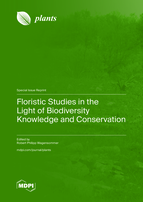Floristic Studies in the Light of Biodiversity Knowledge and Conservation
A special issue of Plants (ISSN 2223-7747).
Deadline for manuscript submissions: closed (31 December 2022) | Viewed by 28674
Special Issue Editor
Interests: conservation; plants; red listing; threatened species; vascular flora; vegetation
Special Issues, Collections and Topics in MDPI journals
Special Issue Information
Dear Colleagues,
Floristic studies are often considered “simply” traditional research. However, the knowledge of the flora of a territory is crucial to slow down the effects of human pressure on biodiversity and essential for most of the research activities in modern botany, such as molecular research on the taxonomy of critical genera, which needs thorough floristic knowledge for the correct identification of the analyzed taxa. Management actions, planning strategies, and biodiversity conservation are only efficient and effective with an in-depth knowledge of how many and what taxa compose the floristic richness of a territory.
Therefore, I am glad to propose this Special Issue (SI), dealing with all aspects of floristic research, with a special focus on biodiversity conservation, poorly known floras, flora of protected areas, and biodiversity hot spots. Floristic research was not only important in the past but has a relevant role in botanical studies still today, even in countries with a long tradition on floristic studies and in which the flora is considered to be already well known.
Prof. Dr. Robert Philipp Wagensommer
Guest Editor
Manuscript Submission Information
Manuscripts should be submitted online at www.mdpi.com by registering and logging in to this website. Once you are registered, click here to go to the submission form. Manuscripts can be submitted until the deadline. All submissions that pass pre-check are peer-reviewed. Accepted papers will be published continuously in the journal (as soon as accepted) and will be listed together on the special issue website. Research articles, review articles as well as short communications are invited. For planned papers, a title and short abstract (about 100 words) can be sent to the Editorial Office for announcement on this website.
Submitted manuscripts should not have been published previously, nor be under consideration for publication elsewhere (except conference proceedings papers). All manuscripts are thoroughly refereed through a single-blind peer-review process. A guide for authors and other relevant information for submission of manuscripts is available on the Instructions for Authors page. Plants is an international peer-reviewed open access semimonthly journal published by MDPI.
Please visit the Instructions for Authors page before submitting a manuscript. The Article Processing Charge (APC) for publication in this open access journal is 2700 CHF (Swiss Francs). Submitted papers should be well formatted and use good English. Authors may use MDPI's English editing service prior to publication or during author revisions.
Keywords
- biodiversity
- chorology
- conservation
- distribution
- ecology
- flora
- herbarium
- plant diversity
- systematics
- taxonomy
- threatened species
- vascular plants







